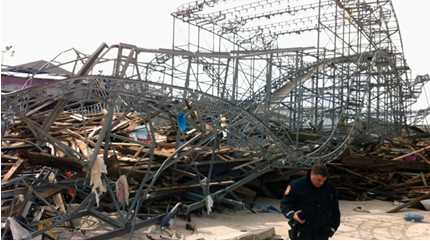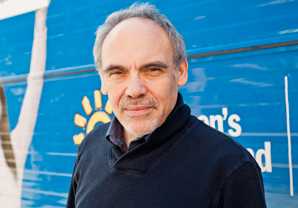Columbia University and University of Albany—Preparedness & Emergency Response Learning Center (PERLC)
On the Front Lines of a Response: PERLC Support During Hurricane Sandy
 During the last days of October 2012, mid-Atlantic area officials began advising residents on the barrier islands to evacuate in preparation for Hurricane Sandy. Among many states, New Jersey, Pennsylvania, New York and those in New England were bracing for what had already surged as a tropical storm in the Caribbean, Bermuda and the southeastern states. Preparedness teams at the regional, state and local levels were geared up for response and recovery efforts. The Centers for Disease Control and Prevention wanted to make sure Americans in the storm’s path were prepared to reduce the risk of any health hazards. Cities identified under a hurricane watch or warnings were encouraged to learn about their local community emergency plans, including the location of emergency shelter and evacuation routes. Two of CDC-funded Preparedness and Emergency Response Learning Centers (PERLC) mobilized to support state and local public health agencies with Hurricane Sandy relief efforts. There are 14 funded PERLCs serving 39 states nationally since 2010.
During the last days of October 2012, mid-Atlantic area officials began advising residents on the barrier islands to evacuate in preparation for Hurricane Sandy. Among many states, New Jersey, Pennsylvania, New York and those in New England were bracing for what had already surged as a tropical storm in the Caribbean, Bermuda and the southeastern states. Preparedness teams at the regional, state and local levels were geared up for response and recovery efforts. The Centers for Disease Control and Prevention wanted to make sure Americans in the storm’s path were prepared to reduce the risk of any health hazards. Cities identified under a hurricane watch or warnings were encouraged to learn about their local community emergency plans, including the location of emergency shelter and evacuation routes. Two of CDC-funded Preparedness and Emergency Response Learning Centers (PERLC) mobilized to support state and local public health agencies with Hurricane Sandy relief efforts. There are 14 funded PERLCs serving 39 states nationally since 2010.
Emergency Risk Communication via Web and Social Media
The Columbia Regional Learning Center (CRLC)
http://www.cdc.gov/phpr/documents/perlcPDFS/ColumbiaPERLC-FinalCOcomments.pdf
played an active role throughout each phase of Hurricane Sandy, timely communicating important preparedness information during the preparedness (72 hours prior to landfall), response, and recovery phases. Successful communication of this information was achieved through the National Center for Disaster Preparedness (NCDP) website updates and providing links to credible resources, as well as social media postings on Facebook and Twitter. Key information made available focused on personal protective measures during all phases and addressed public health preparedness, response, and recovery issues specific to the event. Messaging was communicated to a wider audience by making information available in both English and Spanish. The center also published additional guidance and recommendations on heating and shelter protective measures in regards to the Nor’easter storm that followed Hurricane Sandy.
Media Outlets
CRLC faculty members were actively sought by local and major media outlets for their expertise. Dr. Irwin Redlener, Director, National Center for Disaster Preparedness, appeared on MSNBC, CNN, and CBS News and was quoted in USA Today, Bloomberg BusinessWeek, The Economist, and The Village Voice, to name a few. Dr. Michael Reilly, Director of Planning and Response was also featured on ABC 7 and in The Washington Post, The Atlantic, The NY Post and Remapping Debate. Dr. Redlener and Dr. Reilly wrote an editorial in the New England Journal of Medicine, ‘Lessons from Sandy—Preparing Health Systems for Future Disasters’. Dr. Redlener and Deputy Director Dr. David Abramson also published an editorial, ‘Hurricane Sandy: Lessons Learned Again’ in the Disaster Medicine & Public Health Preparedness journal (Dec 2012).
Hands-on Deployment
A team comprising Drs. Redlener, Abramson, and Reilly accompanied the Children’s Health Fund mobile medical unit team to conduct health care needs assessments in the affected areas. Dr. Reilly was deployed to staff the hospital desk at the Westchester County Emergency Operations Center (EOC) for three days, providing monumental support before, during and after the storm.
 Dr. Irwin Redlener, Professor at the Columbia University’s Mailman School of Public Health and Director of the National Center for Disaster Preparedness.
Dr. Irwin Redlener, Professor at the Columbia University’s Mailman School of Public Health and Director of the National Center for Disaster Preparedness.
After Action Response
Dr. George DiFerdinando, Co-Director of the NY•NJ PERLC, has been actively involved in Hurricane Sandy response and recovery efforts in New Jersey. Initial response activities included assisting the local board of health with sheltering and reception center activities. Since then, various partners have requested his assistance with post-Sandy After Action reviews and analysis to help identify areas of improvement. Recent participation in “hot washes” at the state and local level include the following:
- New Jersey Local Board of Health Association - After Action of Sheltering/Reception Center activities of several Boards of Health
- New Jersey Department of Health and Senior Services (NJDHSS) hot wash of the actions of their Health Command Center (HCC). The NJDHSS HCC focuses on coordination with standing health facilities, either direct care or residential, during an event.
- Mercer County Hot Wash - 13 municipalities reviewed storm related issues, including the sustained power loss (greater than 96 hours) for a majority of the population.
Ongoing activities include collaboration with the New Jersey Public Health Training Center and the New Jersey Learning Management System to identify mid-term and long term trainings suggested by the Sandy and post-Sandy events and project planning sessions with partners at the New Jersey Climate Adaptation Alliance to develop grant proposals for post-Sandy projects.
Efforts Continue….
The National Center for Disaster Preparedness (NCDP) and the New York City-Long Island-Lower Tri-County Public Health Training Center (NYC-LI-LTC PHTC), at Columbia University’s Mailman School of Public Health co-sponsored a live web-conference on January 17, 2013, the “Hurricane Sandy Roundtable: A Conversation Among Local Public Health Leaders.”
This event brought together the public health commissioners from New York City, Suffolk, Nassau, Putnam, Rockland, and Westchester counties along with their respective emergency preparedness planners and response coordinators. These local health department panelists shared experiences, highlighted their challenges, and discussed critical decision-making prior to, during, and following Hurricane Sandy. To view the original broadcasts go to http://ncdp.mailman.columbia.edu/hurricane_sandy.html
- Page last reviewed: April 10, 2015
- Page last updated: April 10, 2015
- Content source:


 ShareCompartir
ShareCompartir